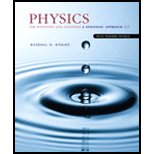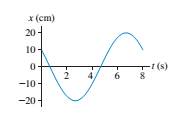
Physics for Scientists and Engineers: A Strategic Approach with Modern Physics (4th Edition)
4th Edition
ISBN: 9780133942651
Author: Randall D. Knight (Professor Emeritus)
Publisher: PEARSON
expand_more
expand_more
format_list_bulleted
Concept explainers
Textbook Question
Chapter 15, Problem 5EAP
What are the (a) amplitude, (b) frequency, and (c) phase constant of the oscillation shown in FIGURE EX15.5?
FIGURE EX15.5

Expert Solution & Answer
Trending nowThis is a popular solution!

Students have asked these similar questions
Use the following information to answer the next question.
Two mirrors meet an angle, a, of 105°. A ray of light is incident upon mirror A at an angle, i, of
42°. The ray of light reflects off mirror B and then enters water, as shown below:
Incident
ray at A
Note: This diagram is not to
scale.
a
Air (n = 1.00)
Water (n = 1.34)
1) Determine the angle of refraction of the ray of light in the water.
B
Hi can u please solve
6. Bending a lens in OpticStudio or OSLO. In either package, create a BK7 singlet lens of 10 mm semi-diameter
and with 10 mm thickness. Set the wavelength to the (default) 0.55 microns and a single on-axis field point at
infinite object distance. Set the image distance to 200 mm. Make the first surface the stop insure that the lens
is fully filled (that is, that the entrance beam has a radius of 10 mm). Use the lens-maker's equation to
calculate initial glass curvatures assuming you want a symmetric, bi-convex lens with an effective focal length
of 200 mm. Get this working and examine the RMS spot size using the "Text" tab of the Spot Diagram analysis
tab (OpticStudio) or the Spd command of the text widnow (OSLO). You should find the lens is far from
diffraction limited, with a spot size of more than 100 microns.
Now let's optimize this lens. In OpticStudio, create a default merit function optimizing on spot size.Then insert
one extra line at the top of the merit function. Assign the…
Chapter 15 Solutions
Physics for Scientists and Engineers: A Strategic Approach with Modern Physics (4th Edition)
Ch. 15 - Prob. 1CQCh. 15 - A pendulum on Planet X, where the value of g is...Ch. 15 - FIGURE Q15.3 shows a position-versus-time graph...Ch. 15 - FIGURE Q15.4 shows a position-versus-time graph...Ch. 15 - 5. Equation 15.25 states that . What does this...Ch. 15 - A block oscillating on a spring has an amplitude...Ch. 15 - A block oscillating on a spring has a maximum...Ch. 15 - 8. The solid disk and circular hoop in FIGURE...Ch. 15 - FIGURE Q15.9 shows the potential-energy diagram...Ch. 15 - Suppose the damping constant b of an oscillator...
Ch. 15 - Prob. 11CQCh. 15 - 12. What is the difference between the driving...Ch. 15 - An air-track glider attached to a spring...Ch. 15 - An air-track is attached to a spring. The glider...Ch. 15 - Prob. 3EAPCh. 15 - An object in SHM oscillates with a period of 4.0 s...Ch. 15 - What are the (a) amplitude, (b) frequency, and (c)...Ch. 15 - What are the (a) amplitude, (b) frequency, and (c)...Ch. 15 - FIGURE EX15.7 is the Position-versus-time graph of...Ch. 15 - FIGURE EX15.8 is the velocity-versus-time graph of...Ch. 15 - An object in simple harmonic motion has an...Ch. 15 - An object in simple harmonic motion has amplitude...Ch. 15 - An object in simple harmonic motion has amplitude...Ch. 15 - An object in simple harmonic motion has amplitude...Ch. 15 - An air-track glider attached to a spring...Ch. 15 - 14. A block attached to a spring with unknown...Ch. 15 - 15. A 200 g air-track glider is attached to a...Ch. 15 - A 200 g mass attached to a horizontal spring...Ch. 15 - Prob. 17EAPCh. 15 - A 1.0 kg block is attached to a spring with spring...Ch. 15 - Prob. 19EAPCh. 15 - Prob. 20EAPCh. 15 - A spring is hanging from the ceiling. Attaching a...Ch. 15 - 22. A spring with spring constant 15 N/m hangs...Ch. 15 - 23. A spring is hung from the ceiling. When a...Ch. 15 - Prob. 24EAPCh. 15 - A 200 g ball is tied to a string. It is pulled to...Ch. 15 - Prob. 26EAPCh. 15 - Prob. 27EAPCh. 15 - Prob. 28EAPCh. 15 - Prob. 29EAPCh. 15 - A 100 g mass on a 1.0-m-long string is pulled 8.0...Ch. 15 - A uniform steel bar swings from a pivot at one end...Ch. 15 - Prob. 32EAPCh. 15 - Prob. 33EAPCh. 15 - Prob. 34EAPCh. 15 - Vision is blurred if the head is vibrated at 29 Hz...Ch. 15 - Prob. 36EAPCh. 15 - Prob. 37EAPCh. 15 - a. When the displacement of a mass on a spring is...Ch. 15 - For a particle in simple harmonic motion, show...Ch. 15 - A 100g block attached to a spring with spring...Ch. 15 - A 0.300 kg oscillator has a speed of 95.4cm/s when...Ch. 15 - An ultrasonic transducer, of the type used in...Ch. 15 - Astronauts in space cannot weigh themselves by...Ch. 15 - 44. Your lab instructor has asked you to measure a...Ch. 15 - A 5.0 kg block hangs from a spring with spring...Ch. 15 - Prob. 46EAPCh. 15 - A block hangs in equilibrium from a vertical...Ch. 15 - Prob. 48EAPCh. 15 -
49. Scientists are measuring the properties of a...Ch. 15 - Prob. 50EAPCh. 15 - A compact car has a mass of 1200 kg. Assume that...Ch. 15 - Prob. 52EAPCh. 15 - Prob. 53EAPCh. 15 - Prob. 54EAPCh. 15 - Prob. 55EAPCh. 15 - Prob. 56EAPCh. 15 - Prob. 57EAPCh. 15 - A uniform rod of mass M and length L swings as a...Ch. 15 - Prob. 59EAPCh. 15 - 60. A 500 g air-track glider attached to a spring...Ch. 15 - Prob. 61EAPCh. 15 - Prob. 62EAPCh. 15 - A molecular bond can be modeled as a spring...Ch. 15 - Prob. 64EAPCh. 15 - Prob. 65EAPCh. 15 - Prob. 66EAPCh. 15 - The 15 g head of a bobble-head doll oscillates in...Ch. 15 - An oscillator with a mass of 500 g and a period of...Ch. 15 - Prob. 69EAPCh. 15 - Prob. 70EAPCh. 15 - Prob. 71EAPCh. 15 - Prob. 72EAPCh. 15 - Prob. 73EAPCh. 15 - A block ona frictionless FIGURE P15.74 to two...Ch. 15 - Prob. 75EAPCh. 15 - Prob. 76EAPCh. 15 - A solid sphere of mass M and radius R is suspended...Ch. 15 - A uniform rod of length L oscillates as a pendulum...Ch. 15 - Prob. 79EAPCh. 15 - Prob. 80EAPCh. 15 - FIGURE CP15.81 shows a 200 g uniform rod pio4ed at...
Knowledge Booster
Learn more about
Need a deep-dive on the concept behind this application? Look no further. Learn more about this topic, physics and related others by exploring similar questions and additional content below.Similar questions
- No chatgpt pls will upvote Already got wrong chatgpt answer .arrow_forwardUse the following information to answer the next question. Two mirrors meet an angle, a, of 105°. A ray of light is incident upon mirror A at an angle, i, of 42°. The ray of light reflects off mirror B and then enters water, as shown below: A Incident ray at A Note: This diagram is not to scale. Air (n = 1.00) Water (n = 1.34) Barrow_forwardUse the following information to answer the next question. Two mirrors meet an angle, a, of 105°. A ray of light is incident upon mirror A at an angle, i, of 42°. The ray of light reflects off mirror B and then enters water, as shown below: A Incident ray at A Note: This diagram is not to scale. Air (n = 1.00) Water (n = 1.34) Barrow_forward
- Good explanation it sure experts solve it.arrow_forwardNo chatgpt pls will upvote Asaparrow_forwardA satellite has a mass of 100kg and is located at 2.00 x 10^6 m above the surface of the earth. a) What is the potential energy associated with the satellite at this loction? b) What is the magnitude of the gravitational force on the satellite?arrow_forward
- No chatgpt pls will upvotearrow_forwardCorrect answer No chatgpt pls will upvotearrow_forwardStatistical thermodynamics. The number of imaginary replicas of a system of N particlesa) cannot be greater than Avogadro's numberb) must always be greater than Avogadro's number.c) has no relation to Avogadro's number.arrow_forward
- Lab-Based Section Use the following information to answer the lab based scenario. A student performed an experiment in an attempt to determine the index of refraction of glass. The student used a laser and a protractor to measure a variety of angles of incidence and refraction through a semi-circular glass prism. The design of the experiment and the student's results are shown below. Angle of Incidence (°) Angle of Refraction (º) 20 11 30 19 40 26 50 31 60 36 70 38 2a) By hand (i.e., without using computer software), create a linear graph on graph paper using the student's data. Note: You will have to manipulate the data in order to achieve a linear function. 2b) Graphically determine the index of refraction of the semi-circular glass prism, rounding your answer to the nearest hundredth.arrow_forwardUse the following information to answer the next two questions. A laser is directed at a prism made of zircon (n = 1.92) at an incident angle of 35.0°, as shown in the diagram. 3a) Determine the critical angle of zircon. 35.0° 70° 55 55° 3b) Determine the angle of refraction when the laser beam leaves the prism.arrow_forwardUse the following information to answer the next two questions. A laser is directed at a prism made of zircon (n = 1.92) at an incident angle of 35.0°, as shown in the diagram. 3a) Determine the critical angle of zircon. 35.0° 70° 55 55° 3b) Determine the angle of refraction when the laser beam leaves the prism.arrow_forward
arrow_back_ios
SEE MORE QUESTIONS
arrow_forward_ios
Recommended textbooks for you
 Physics for Scientists and Engineers: Foundations...PhysicsISBN:9781133939146Author:Katz, Debora M.Publisher:Cengage Learning
Physics for Scientists and Engineers: Foundations...PhysicsISBN:9781133939146Author:Katz, Debora M.Publisher:Cengage Learning University Physics Volume 1PhysicsISBN:9781938168277Author:William Moebs, Samuel J. Ling, Jeff SannyPublisher:OpenStax - Rice University
University Physics Volume 1PhysicsISBN:9781938168277Author:William Moebs, Samuel J. Ling, Jeff SannyPublisher:OpenStax - Rice University Principles of Physics: A Calculus-Based TextPhysicsISBN:9781133104261Author:Raymond A. Serway, John W. JewettPublisher:Cengage Learning
Principles of Physics: A Calculus-Based TextPhysicsISBN:9781133104261Author:Raymond A. Serway, John W. JewettPublisher:Cengage Learning College PhysicsPhysicsISBN:9781938168000Author:Paul Peter Urone, Roger HinrichsPublisher:OpenStax College
College PhysicsPhysicsISBN:9781938168000Author:Paul Peter Urone, Roger HinrichsPublisher:OpenStax College Classical Dynamics of Particles and SystemsPhysicsISBN:9780534408961Author:Stephen T. Thornton, Jerry B. MarionPublisher:Cengage Learning
Classical Dynamics of Particles and SystemsPhysicsISBN:9780534408961Author:Stephen T. Thornton, Jerry B. MarionPublisher:Cengage Learning College PhysicsPhysicsISBN:9781305952300Author:Raymond A. Serway, Chris VuillePublisher:Cengage Learning
College PhysicsPhysicsISBN:9781305952300Author:Raymond A. Serway, Chris VuillePublisher:Cengage Learning

Physics for Scientists and Engineers: Foundations...
Physics
ISBN:9781133939146
Author:Katz, Debora M.
Publisher:Cengage Learning

University Physics Volume 1
Physics
ISBN:9781938168277
Author:William Moebs, Samuel J. Ling, Jeff Sanny
Publisher:OpenStax - Rice University

Principles of Physics: A Calculus-Based Text
Physics
ISBN:9781133104261
Author:Raymond A. Serway, John W. Jewett
Publisher:Cengage Learning

College Physics
Physics
ISBN:9781938168000
Author:Paul Peter Urone, Roger Hinrichs
Publisher:OpenStax College

Classical Dynamics of Particles and Systems
Physics
ISBN:9780534408961
Author:Stephen T. Thornton, Jerry B. Marion
Publisher:Cengage Learning

College Physics
Physics
ISBN:9781305952300
Author:Raymond A. Serway, Chris Vuille
Publisher:Cengage Learning
SIMPLE HARMONIC MOTION (Physics Animation); Author: EarthPen;https://www.youtube.com/watch?v=XjkUcJkGd3Y;License: Standard YouTube License, CC-BY